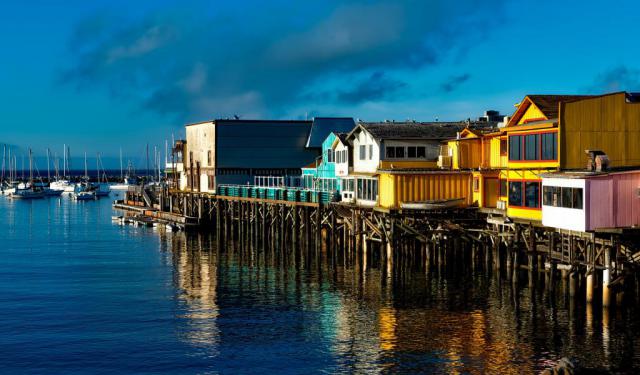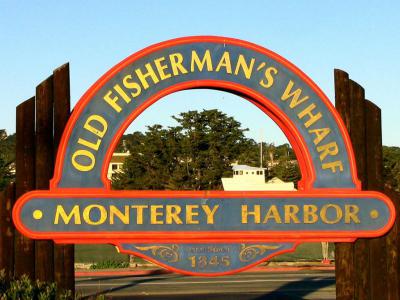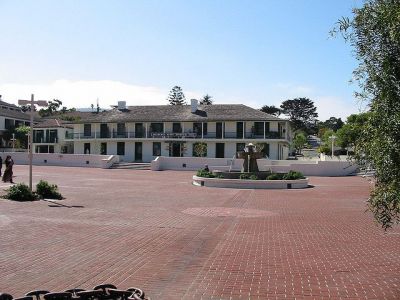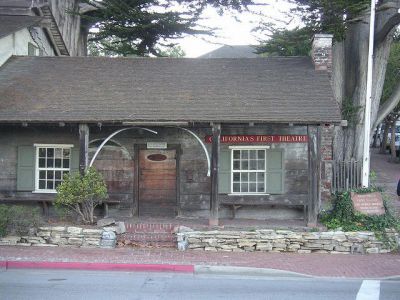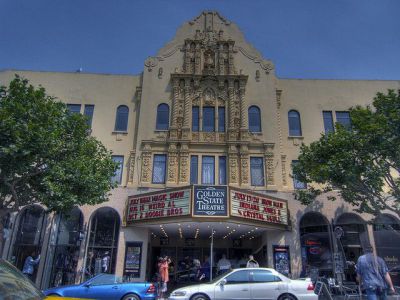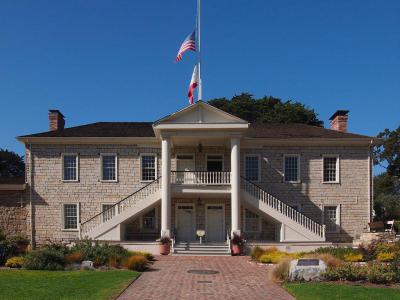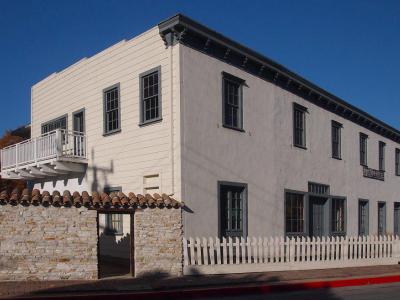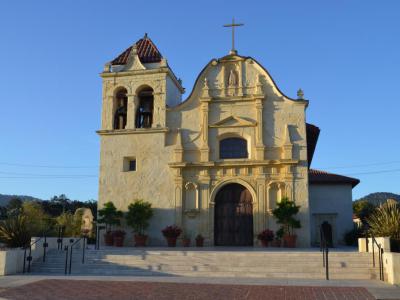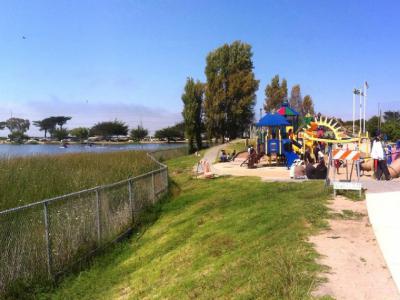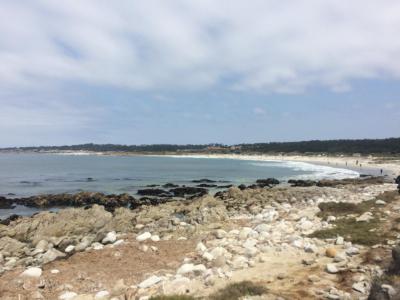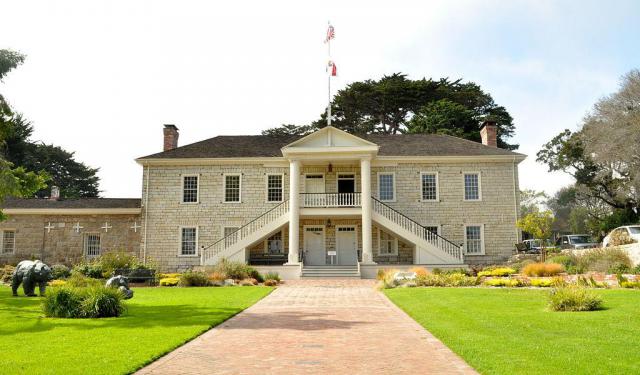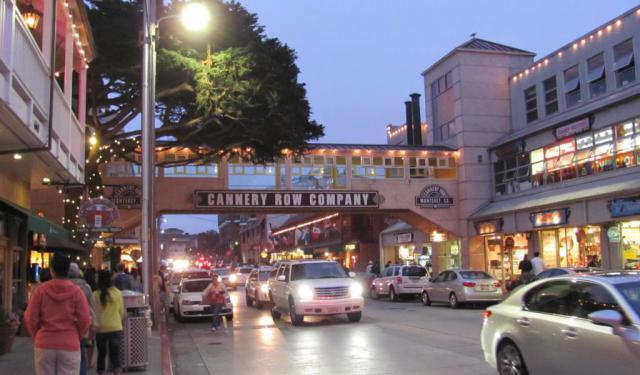Monterey Introduction Walking Tour (Self Guided), Monterey
Monterey is one of California's oldest cities, having been settled since 1770. The Spanish and Mexican governments both used the city as a capital for Alta California. Monterey offered many important firsts for California during this era, including a newspaper and printing press, public school, library, and theater.
This city was the location for the first constitutional convention in California after its acquisition by the United States. Painters and writers have enjoyed this area since the late 19th century, with the area's beauty providing inspiration. The fishing industry was significant until the 1950s, and the healthcare, educational publishing, and fresh produce industries are essential today.
If you want to immerse yourself in the whole experience as fully as possible, Old Fisherman's Wharf is the perfect place for shopping, dining, and local activities. The Stevenson House, where novelist Robert Louis Stevenson lived in the late 19th century, is one of the most iconic landmarks.
Savor more of the fascinating historic sites in Monterey State Historic Park. One of the most exciting kid-friendly outdoor areas is Dennis the Menace Park, and Del Monte Beach is a place you don't want to miss if you enjoy being near the water.
Theater buffs will want to visit California's First Theatre or the Golden State Theatre. The Monterey Museum of Art has a varied collection that also includes historical artifacts. To gain a greater appreciation of the city's religious heritage, see the Cathedral of San Carlos Borromeo.
Take this self-guided walking tour to learn more about Monterey and its attractions.
This city was the location for the first constitutional convention in California after its acquisition by the United States. Painters and writers have enjoyed this area since the late 19th century, with the area's beauty providing inspiration. The fishing industry was significant until the 1950s, and the healthcare, educational publishing, and fresh produce industries are essential today.
If you want to immerse yourself in the whole experience as fully as possible, Old Fisherman's Wharf is the perfect place for shopping, dining, and local activities. The Stevenson House, where novelist Robert Louis Stevenson lived in the late 19th century, is one of the most iconic landmarks.
Savor more of the fascinating historic sites in Monterey State Historic Park. One of the most exciting kid-friendly outdoor areas is Dennis the Menace Park, and Del Monte Beach is a place you don't want to miss if you enjoy being near the water.
Theater buffs will want to visit California's First Theatre or the Golden State Theatre. The Monterey Museum of Art has a varied collection that also includes historical artifacts. To gain a greater appreciation of the city's religious heritage, see the Cathedral of San Carlos Borromeo.
Take this self-guided walking tour to learn more about Monterey and its attractions.
How it works: Download the app "GPSmyCity: Walks in 1K+ Cities" from Apple App Store or Google Play Store to your mobile phone or tablet. The app turns your mobile device into a personal tour guide and its built-in GPS navigation functions guide you from one tour stop to next. The app works offline, so no data plan is needed when traveling abroad.
Monterey Introduction Walking Tour Map
Guide Name: Monterey Introduction Walking Tour
Guide Location: USA » Monterey (See other walking tours in Monterey)
Guide Type: Self-guided Walking Tour (Sightseeing)
# of Attractions: 9
Tour Duration: 2 Hour(s)
Travel Distance: 3.8 Km or 2.4 Miles
Author: nicole
Sight(s) Featured in This Guide:
Guide Location: USA » Monterey (See other walking tours in Monterey)
Guide Type: Self-guided Walking Tour (Sightseeing)
# of Attractions: 9
Tour Duration: 2 Hour(s)
Travel Distance: 3.8 Km or 2.4 Miles
Author: nicole
Sight(s) Featured in This Guide:
- Old Fisherman's Wharf
- Monterey State Historic Park
- California's First Theatre
- Golden State Theatre
- Colton Hall Museum
- Stevenson House
- San Carlos Cathedral
- Dennis the Menace Park
- Del Monte Beach
1) Old Fisherman's Wharf (must see)
Old Fisherman's Wharf is one of Monterey's most popular tourist attractions, with good reason. This area of the city is the go-to location for whale-watching, bay cruises, and some of the best opportunities for shopping and dining. Watching marine life ranging from pelicans to seals to sea otters is one of the activities that visitors here enjoy the most.
When you check out the dining opportunities here, you'll be able to enjoy freshly-caught seafood from Big Fish Grill, Abalonetti Seafood, or Crab Louie's Bistro. Crabby Jim's, Domenico's on the Wharf, and Paluca Trattoria are favorites for Italian food. The restaurants offer a range of environments that range from casual to upscale, providing something for everyone.
You can take advantage of exciting shopping opportunities, including pearls and fine jewelry from Morning Star Pearls. Harbor House Gifts is your go-to location for Murano glass from Venice and paintings. Stop by Sock Harbor Monterey for their signature socks and other unique clothing.
When you check out the dining opportunities here, you'll be able to enjoy freshly-caught seafood from Big Fish Grill, Abalonetti Seafood, or Crab Louie's Bistro. Crabby Jim's, Domenico's on the Wharf, and Paluca Trattoria are favorites for Italian food. The restaurants offer a range of environments that range from casual to upscale, providing something for everyone.
You can take advantage of exciting shopping opportunities, including pearls and fine jewelry from Morning Star Pearls. Harbor House Gifts is your go-to location for Murano glass from Venice and paintings. Stop by Sock Harbor Monterey for their signature socks and other unique clothing.
2) Monterey State Historic Park (must see)
Monterey State Historic Park preserves a compact but rich collection of buildings that trace California’s early political, commercial, and cultural development. Set within the historic core of Monterey, the former capital under both Spanish and Mexican rule, the park brings together adobe homes, civic structures, and maritime facilities that reflect the region’s rich and layered past. Many of these buildings date to the early 1800s and formed the heart of a busy port city that once governed a vast stretch of the Pacific coast. Today, the park offers visitors a clear sense of this formative era through its carefully maintained architecture and interpretive exhibits.
Among the most significant sites is the Custom House, widely recognised as the oldest surviving government building in California. Constructed during the Mexican period, it served as the administrative hub for trade, customs duties, and official inspections. It was also here that the U.S. flag was raised in 1846, marking the beginning of American governance in California. Its simple, sturdy adobe form still anchors the waterfront, reminding visitors of Monterey’s role as a major trading port.
A short distance inland stands the Pacific House, another key highlight of the park. Built in the 1840s, it originally served various civic and commercial purposes, including a hotel and government offices. Today, it serves as a museum, presenting exhibits on Monterey’s multicultural history, regional trade networks, and the diverse communities that have shaped the city’s growth. Its restored rooms and displays help contextualise the broader story presented throughout the park.
Together, these landmarks—along with others such as the Stevenson House, Larkin House, and Casa del Oro—form a walkable network that reveals Monterey’s evolution across Spanish, Mexican, and early American periods. For visitors, the park provides an accessible introduction to the city’s historic landscape, offering a thoughtful balance of architecture, interpretation, and quiet coastal atmosphere.
Among the most significant sites is the Custom House, widely recognised as the oldest surviving government building in California. Constructed during the Mexican period, it served as the administrative hub for trade, customs duties, and official inspections. It was also here that the U.S. flag was raised in 1846, marking the beginning of American governance in California. Its simple, sturdy adobe form still anchors the waterfront, reminding visitors of Monterey’s role as a major trading port.
A short distance inland stands the Pacific House, another key highlight of the park. Built in the 1840s, it originally served various civic and commercial purposes, including a hotel and government offices. Today, it serves as a museum, presenting exhibits on Monterey’s multicultural history, regional trade networks, and the diverse communities that have shaped the city’s growth. Its restored rooms and displays help contextualise the broader story presented throughout the park.
Together, these landmarks—along with others such as the Stevenson House, Larkin House, and Casa del Oro—form a walkable network that reveals Monterey’s evolution across Spanish, Mexican, and early American periods. For visitors, the park provides an accessible introduction to the city’s historic landscape, offering a thoughtful balance of architecture, interpretation, and quiet coastal atmosphere.
3) California's First Theatre
The First Theater, also known as California's earliest theater, is a notable structure made of adobe and wood located in Monterey, California. It was constructed between 1846 and 1847 by Jack Swan, an English sailor and early settler. Initially, it served as a lodging and tavern for sailors. This venue hosted California's first theater shows. On January 31, 1934, it was recognized as a California Historical Landmark.
Jack Swan bought land in Monterey around 1845-47, before the American takeover in July 1846. The First Theater was built on what is now the corner of Pacific and Scott Streets. Its construction happened in two phases: initially, a small wooden part was built around 1845 from shipwreck lumber, serving as a boarding house and tavern for sailors. This section had four two-room units, each with its own fireplace and doors on both sides. The rooms had adjustable partitions.
Swan then added a larger adobe section in late 1847, intended as a sailor's boarding house but later transformed into a theater. This happened when four soldiers from Santa Barbara and three local comedians organized a minstrel show. The theater was 75 feet long and 12 feet wide, accommodating 200 people, with a pit and stage. The space had a wooden curtain on hinges that could be moved up and down. Event programs were handwritten, and posters were made using a blacking pot and brush.
Jack Swan bought land in Monterey around 1845-47, before the American takeover in July 1846. The First Theater was built on what is now the corner of Pacific and Scott Streets. Its construction happened in two phases: initially, a small wooden part was built around 1845 from shipwreck lumber, serving as a boarding house and tavern for sailors. This section had four two-room units, each with its own fireplace and doors on both sides. The rooms had adjustable partitions.
Swan then added a larger adobe section in late 1847, intended as a sailor's boarding house but later transformed into a theater. This happened when four soldiers from Santa Barbara and three local comedians organized a minstrel show. The theater was 75 feet long and 12 feet wide, accommodating 200 people, with a pit and stage. The space had a wooden curtain on hinges that could be moved up and down. Event programs were handwritten, and posters were made using a blacking pot and brush.
4) Golden State Theatre
The Golden State Theatre dates back to 1926, and at its height was a venue that rivaled theaters in California's bigger cities. This Monterey landmark has undergone restoration to preserve its former glory. The mezzanine and lobby areas feature an Old World style, and the auditorium area of the theater boasts 1,000 seats.
Some of the entertainment options here include film festivals and concerts. Some of the top performers that have included The Smothers Brothers, Willie Nelson, and B.B. King. The range of performers this theater has hosted helps demonstrate its overall versatility as a venue and why it has remained so popular.
The architectural style is that of a Castillian castle, reminiscent of the "movie palace" days. A highlight inside the theater is a fresco that has glimpses of the sky around its edges. The effect that this fresco produces resembles that of an open courtyard, giving audiences a unique experience.
Some of the entertainment options here include film festivals and concerts. Some of the top performers that have included The Smothers Brothers, Willie Nelson, and B.B. King. The range of performers this theater has hosted helps demonstrate its overall versatility as a venue and why it has remained so popular.
The architectural style is that of a Castillian castle, reminiscent of the "movie palace" days. A highlight inside the theater is a fresco that has glimpses of the sky around its edges. The effect that this fresco produces resembles that of an open courtyard, giving audiences a unique experience.
5) Colton Hall Museum
Colton Hall, constructed in the 1840s by Walter Colton, originally arrived in Monterey as a chaplain aboard Commodore Stockton's vessel. He later assumed the role of Monterey's inaugural alcalde (mayor) during the American Period.
Initially, Colton Hall served as both a public school and a venue for government meetings. It gained historical significance as the site of California's inaugural constitutional convention in 1849. At that time, California's military governor convened the convention in Colton Hall, situated in Monterey. Delegates from ten districts gathered in Monterey on September 1 to deliberate and draft California's inaugural constitution. The California Constitution was ratified on October 13, voted upon in the same year's November, and subsequently forwarded to Congress in January 1850. San Jose was designated as the location for the first Legislature, as per the official definition of a State Capital, which is where the Legislature convenes; hence, Monterey never held the title of State Capitol.
In 1903, the Native Sons of the Golden West played a pivotal role in securing legislative funding for necessary repairs to Colton Hall. Over the years, Colton Hall has served various public functions, including housing Monterey's City Hall, a public school, the county courthouse, the sheriff's office, and Monterey's city police headquarters. Presently, some city offices, such as the city Planning Division and Building Safety Division, occupy the main floor, while the second floor functions as a museum. This historic building remains in continuous use and holds a central position in the history of Monterey County.
Initially, Colton Hall served as both a public school and a venue for government meetings. It gained historical significance as the site of California's inaugural constitutional convention in 1849. At that time, California's military governor convened the convention in Colton Hall, situated in Monterey. Delegates from ten districts gathered in Monterey on September 1 to deliberate and draft California's inaugural constitution. The California Constitution was ratified on October 13, voted upon in the same year's November, and subsequently forwarded to Congress in January 1850. San Jose was designated as the location for the first Legislature, as per the official definition of a State Capital, which is where the Legislature convenes; hence, Monterey never held the title of State Capitol.
In 1903, the Native Sons of the Golden West played a pivotal role in securing legislative funding for necessary repairs to Colton Hall. Over the years, Colton Hall has served various public functions, including housing Monterey's City Hall, a public school, the county courthouse, the sheriff's office, and Monterey's city police headquarters. Presently, some city offices, such as the city Planning Division and Building Safety Division, occupy the main floor, while the second floor functions as a museum. This historic building remains in continuous use and holds a central position in the history of Monterey County.
6) Stevenson House
In 1879, Scottish novelist Robert Louis Stevenson stayed at the French Hotel, now called the Stevenson House after him and dedicated to his memory. Stevenson lived there while recovering his health as he was crossing the United States to court his future wife Fanny Osbourne. While there, he often dined "on the cuff," as he said, at a nearby restaurant run by Frenchman Jules Simoneau which stood at what is now Simoneau Plaza.
Several years later, Stevenson sent Simoneau an inscribed copy of his novel Strange Case of Dr Jekyll and Mr Hyde (1886), writing that it would be a stranger case still if Robert Louis Stevenson ever forgot Jules Simoneau. Stevenson wrote some articles for the local Monterey newspaper, including one that beautifully evoked "the Old Pacific Capital."
The Stevenson House features a bas relief depicting the sickly author writing in bed. Today the building has been designated as a California Historical Landmark.
Several years later, Stevenson sent Simoneau an inscribed copy of his novel Strange Case of Dr Jekyll and Mr Hyde (1886), writing that it would be a stranger case still if Robert Louis Stevenson ever forgot Jules Simoneau. Stevenson wrote some articles for the local Monterey newspaper, including one that beautifully evoked "the Old Pacific Capital."
The Stevenson House features a bas relief depicting the sickly author writing in bed. Today the building has been designated as a California Historical Landmark.
7) San Carlos Cathedral (must see)
The Cathedral of San Carlos Borromeo, also known as the Royal Presidio Chapel, stands as a Roman Catholic cathedral situated in Monterey. This historic cathedral holds the distinction of being the oldest continuously functioning parish and the oldest stone structure in California. Its construction took place between 1791 and 1794, rendering it the oldest and smallest active cathedral in the United States, alongside Saint Louis Cathedral in New Orleans, Louisiana. It also holds the distinction of being the sole remaining presidio chapel in California and the sole surviving edifice from the original Monterey Presidio.
This church's roots trace back to its founding by the Franciscan Father Junípero Serra, initially established as the chapel of Mission San Carlos Borromeo de Carmelo on June 3, 1770. By May 1771, the viceroy had granted Serra's request to relocate the mission from the Presidio to its current location near the mouth of the Carmel River, where the present-day town of Carmel-by-the-Sea stands. The newly established mission was then christened Mission San Carlos Borromeo de Carmelo.
Following the mission's relocation, the preexisting wooden and adobe structure transformed into the San Jose Chapel for the Presidio of Monterey. Monterey ascended to the role of the capital of the Province of Californias in 1777, leading to the renaming of the chapel as the Royal Presidio Chapel. Tragically, the original church succumbed to fire in 1789, leading to its replacement by the current sandstone edifice, which saw completion in 1794 through the labor of Indigenous workers. This structure took the form of a Latin Cross and bears the distinction of being California's inaugural stone building. It exemplifies the refined Spanish Colonial architectural style of the late 18th century.
This church's roots trace back to its founding by the Franciscan Father Junípero Serra, initially established as the chapel of Mission San Carlos Borromeo de Carmelo on June 3, 1770. By May 1771, the viceroy had granted Serra's request to relocate the mission from the Presidio to its current location near the mouth of the Carmel River, where the present-day town of Carmel-by-the-Sea stands. The newly established mission was then christened Mission San Carlos Borromeo de Carmelo.
Following the mission's relocation, the preexisting wooden and adobe structure transformed into the San Jose Chapel for the Presidio of Monterey. Monterey ascended to the role of the capital of the Province of Californias in 1777, leading to the renaming of the chapel as the Royal Presidio Chapel. Tragically, the original church succumbed to fire in 1789, leading to its replacement by the current sandstone edifice, which saw completion in 1794 through the labor of Indigenous workers. This structure took the form of a Latin Cross and bears the distinction of being California's inaugural stone building. It exemplifies the refined Spanish Colonial architectural style of the late 18th century.
8) Dennis the Menace Park (must see)
Dennis the Menace Park is one of Monterey's most iconic playgrounds, named after the cartoon character. The playground dates back to 1956 and has undergone renovations over the years to keep it up to date. This attraction is next to a youth center and baseball field, making it a favorite family destination.
This park has a lake where you can enjoy ducks and other waterfowl. There is an excellent view of the harbor where you can see local boats coming and going. You'll also enjoy the picnic area, which is the perfect place to enjoy a meal or snack.
You won't want to miss the treats that await in the playground area. Kids will enjoy going down the roller slide. There is also a rope bridge that helps add to the excitement. Don't miss seeing the Dennis the Menace statue, which is perfect for selfies and other photo opportunities while here.
This park has a lake where you can enjoy ducks and other waterfowl. There is an excellent view of the harbor where you can see local boats coming and going. You'll also enjoy the picnic area, which is the perfect place to enjoy a meal or snack.
You won't want to miss the treats that await in the playground area. Kids will enjoy going down the roller slide. There is also a rope bridge that helps add to the excitement. Don't miss seeing the Dennis the Menace statue, which is perfect for selfies and other photo opportunities while here.
9) Del Monte Beach
Del Monte Beach is a beautiful Monterey beach that many see as a hidden treasure. The location is somewhat less crowded than some other beaches in the area, increasing its appeal for people seeking a quieter beach day. If you enjoy watching people surfing, this beach is one of the best locations.
One of the things that people enjoy the most about this beach is walking along the boardwalk that leads through the sand dunes. You can easily enjoy a picnic, courtesy of the picnic tables provided. If you decide you need a rest while journeying along the boardwalk, catch a break on one of the benches.
If you enjoy watching wildlife, this beach is an excellent place to do so. There are sea and migratory birds that feed along the shore regularly. When you're at the beach, you may have the privilege of seeing seals in the water or frolicking along the beach.
One of the things that people enjoy the most about this beach is walking along the boardwalk that leads through the sand dunes. You can easily enjoy a picnic, courtesy of the picnic tables provided. If you decide you need a rest while journeying along the boardwalk, catch a break on one of the benches.
If you enjoy watching wildlife, this beach is an excellent place to do so. There are sea and migratory birds that feed along the shore regularly. When you're at the beach, you may have the privilege of seeing seals in the water or frolicking along the beach.
Walking Tours in Monterey, California
Create Your Own Walk in Monterey
Creating your own self-guided walk in Monterey is easy and fun. Choose the city attractions that you want to see and a walk route map will be created just for you. You can even set your hotel as the start point of the walk.
Monterey State Historic Park Walk
Monterey State Historic Park is a National Landmark and a part of the Monterey Old Town Historic District. Found on the grounds here are a group of significant old-time houses that once made up California's earliest capital and were the site of the state's first constitutional convention. Today these buildings retain their rich heritage, preserving an important part of Californian as... view more
Tour Duration: 1 Hour(s)
Travel Distance: 1.9 Km or 1.2 Miles
Tour Duration: 1 Hour(s)
Travel Distance: 1.9 Km or 1.2 Miles
Cannery Row Walking Tour
Cannery Row – the waterfront street in Monterey, California – was once home to a number of sardine canning factories, the last of which closed down in 1973. The former nickname for Ocean View Avenue became the street's official name in January 1958 to honor John Steinbeck and his famous eponymous novel. In the novel's opening sentence, Steinbeck described Cannery Row as "a poem,... view more
Tour Duration: 1 Hour(s)
Travel Distance: 1.8 Km or 1.1 Miles
Tour Duration: 1 Hour(s)
Travel Distance: 1.8 Km or 1.1 Miles
The Most Popular Cities
/ view all
